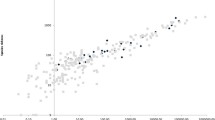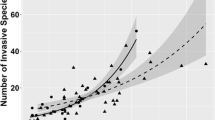Abstract
Survey of eighteen islands in the Stockholm archipelago from 1884–1908 was re-examined during 1996–1998 to investigate how island size, degree of isolation and human impact affect the species number, extinction and immigration rates of terrestrial vascular plants. Cattle grazing and haymaking was widely and commonly in practice on the islands, but became less intensive since the 1920s and ceased during the 1960s.
In the first survey species number was positively correlated with area and negatively correlated with distance to mainland. This pattern was similar in the later survey. However, the number of surrounding islands was positively correlated with island specific species number. During the period from the first to the second survey twenty species disappeared and ninety-three appeared as new. The increased abundance of trees, bushes and shade tolerant herbs suggest that this increase in species number is the effect of an ongoing succession in the landscape. The absolute extinction rate was negatively correlated with island size and distance to mainland, while the immigration rate was positively correlated to island size. The extinction rate was negatively correlated with the distance to mainland probably due to an earlier more intense cultural exploitation closer to the mainland. Our measure of human impact, the presence of houses on islands, was not related to terrestrial plant species number or extinction rate. However, there was a trend for the immigration rate to be higher on islands with houses in 1942 than those without, indicating the importance of human activities for dispersal and/or recruitment.
Similar content being viewed by others
References
Abbott I. (1977): Species richness, turnover and equilibrium in insular floras near Perth, western Australia.Austral. J. Bot. 25: 193–208.
Abbott I. (1983): The meaning of z in species/area regressions and the study of species turnover in island biogeography.Oikos 41: 385–390.
Arrhenius O. (1920):Ökologische studien in den Stockholme schären — Ekologiska studier i Stockholms skärgård. Stockholms högskola, Stockholm.
Buckley R.C. (1981): Scale-dependent equilibrium in highly heterogeneous islands: plant geography of the northern Great Barrier Reef sand cays and single islets.Austral. J. Ecol. 6: 143–147.
Buckley R.C. (1985): Distinguishing the effects of area and habitat type on island plant species richness by separating floristic elements and substrate type and controlling for island size.J. Biogeogr. 12: 527–535.
Buckley R.C. &Knedlhans S.B. (1986): Beachcomber biogeography: interception of dispersing propagules by islands.J. Biogeogr. 13: 339–344.
Chown S.L., Gremmen N.J. M. &Gaston K.J. (1998): Ecological biography of southern ocean islands: Species-area relationships, human impacts, and conservation.Amer. Naturalist 152: 562–575.
Connor E.F., Earl D.M. &Cosby B.J. (1983): Model discrimination and expected slope values in species-area studies.Amer. Naturalist 122: 789–796.
Diamond J.M. &May R.M. (1977): Species turnover rates on islands: Dependence on census interval.Science 197: 266–270.
Donner J. (1995):The Quaternary history of Scandinavia. Cambridge Univ. Press, Cambridge.
Drayton B. &Primack R.B. (1996): Plant species lost in an isolated conservation area in metropolitan Boston from 1894 to 1993.Conservation Biol. 10: 30–39.
Dzwonko Z. &Loster S. (1989): Distribution of vascular plant species in small woodlands on the Western Carpathian foothills.Oikos 56: 77–86.
Ekstam U. &Forshed N. (1992):Om hävden upphör (If grassland management ceases). Naturvårdsverket, Solna.
Engeström T. &Erhardt R. (1931): Från holmarna kring Runmarö (Floristic notations from the islands around Runmarö).Bot. Notiser 16: 230–268.
Ericson L. &Wallentinus H.-G. (1977): Seashore vegetation around the Gulf of Bothnia.Wahlenbergia 5: 1–42.
Fischer S.F., Poschlod P. &Beinlich B. (1995): Die Bedeutung der Wanderschäferei für den Artenaustausch zwischen isolierten Schaftrifen.Beih. Veröff. Naturschutz Landschaftspflege Baden-Württemberg 83: 229–256.
Gilbert F.S. (1980): The equilibrium theory of island biogeography: fact or fiction?J. Biogeogr. 7: 209–235.
Hamner J.W. (1909):Redogörelse för resultat av en med understöd ur C.W. Sebardts stipendiefond företagen resa för växtgeografiska studier inom Blidö socken i Stockholms skärgård under sommaren 1908 (Report from a journey, funded by C.W. Sebardts grants, studying plant geography in Blidö parish during the summer 1908). Gotlänningens Tryckeri, Visby.
Hanski I. (1982): Dynamics of regional distribution: the core and satellite species hypothesis.Oikos 38: 210–221.
Heatwole H. (1991): Factors affecting the number of species of plants on islands of the Great Barrier Reef, Australia.J. Biogeogr. 18: 213–221.
Hedenstierna B. (1989):Skärgårdsöar och fiskekobbar. Del 1. Norra skärgården genom tiderna (Islands and fishing islets. Part 1. The history of the northern archipelago). Rabén & Sjögren, Stockholm.
Hodkinson D.J. &Thomson K. (1997): Plant dispersal: the role of man.J. Appl. Ecol. 34: 1484–1496.
Jansson A. (1924): Tillägg till Stockholmstraktens växter (Addtion to the plants of Stockholm, in Swedish).Svensk Bot. Tidskr. 18: 507–510.
Jerling L. (1998): Linnaeus’ Flora Kofsöensis revisited — floristic changes during 260 years in a small island of the lake Mälaren.Nord. J. Bot. 18: 667–680.
Kohn D.D. &Walsh M.D. (1994): Plant species richness — the effect of island size and habitat diversity.J. Ecol. 82: 367–377.
Kristiansson A.L. (1947): Studier i Stockholms norra skärgård (Studies in the northern part of the Stockholm Archipelago).Geogr. Ann. 29: 49–127.
Krok T.O.B.N. &Almquist S. (1994):Svensk flora (Flora of Sweden). Almqvist & Wiksell, Uppsala.
Macarthur R. &Wilson E.O. (1967):The theory of island biogeography. Princeton University Press, Princeton.
Nilsson I.N. &Nilsson S.G. (1982): Turnover of vascular plant species on small islands in lake Mökeln, south Sweden 1976–1980.Oecologia 53: 128–133.
Nilsson I.N. &Nilsson S.G. (1985): Experimental estimates of census efficiency and pseudoturnover on islands: error trend and between-observer variation when recording vascular plants.J. Ecol. 73: 65–70.
Nilsson S.G. &Nilsson I.N. (1978): Species richness and dispersal of vascular plants to islands in lake Möckeln, southern Sweden.Ecology 59: 473–480.
Ouborg N.J. (1993): Isolation, population size and extinction: the classical and metapopulation approaches applied to vascular plants along the Dutch Rhine-system.Oikos 66: 298–308.
Pimm S.L., Jones H.L. &Diamond J.M. (1988): On the risk of extinction.Amer. Naturalist 132: 757–785.
Power D.M. (1972): Number of bird species on the California islands.Evolution 26: 451–461.
Rinaldo S. (1968):Skärgård i förvandling (Archipelago in transformation). Rabén & Sjögren, Stockholm.
Roden C.M. (1998): Persistence, extinction and different species pools within the flora of lake islands in western Ireland.J. Biogeogr. 25: 301–310.
Romell L.-G. (1915): Gränser och zoner i Stockholms yttre skärgård (Boundaries and zones in the outer part of the Stockholm archipelago).Svensk Bot. Tidskr. 9: 133–159.
Rydin H. &Borgegård S.-O. (1988): Plant species richness on islands over a centuary of primary succession: lake Hjälmaren.Ecology 69: 916–927.
Schoener T.W. (1988): On testing the MacArthur-Wilson model with data on rates.Amer. Naturalist 131: 847–864.
Simberloff D. (1976): Species turnover and equilibrium island biogeography.Science 194: 572–578.
Tyler T. &Olsson K.-A. (1997): Changes in the flora of Scania during the years 1938–1996 — a statistical analysis of the results of two large-scale surveys.Svensk Bot. Tidskr. 91: 143–185.
Vartiainen T. (1968): Observations on the plant succession of the islands of Krunnit, in the Gulf of Bothnia.Aquilo, Ser. Bot. 6: 158–171.
Welter-Schultes F.W. &Williams M.R. (1999): History, island area and habitat availability determine land snail species richness of Aegean islands.J. Biogeogr. 26: 239–249.
Whittaker R.J., Bush M.B. &Richards K. (1989): Plant recolonization and vegetation succession on the Krakatau isalands, Indonesia.Ecol. Monogr. 59: 59–123.
Williamson M. (1988): Relationship of species number to area, distance and other variables. In:Myers A.A. &Giller P.S. (eds.),Analytical biogeography: An integrated approch to the study of animal and plant distributions, Chapman and Hall Ltd., London, pp. 91–115.
Author information
Authors and Affiliations
Corresponding author
Rights and permissions
About this article
Cite this article
Löfgren, A., Jerling, L. Species richness, extinction and immigration rates of vascular plants on islands in the Stockholm archipelago, Sweden, during a century of ceasing management. Folia Geobot 37, 297–308 (2002). https://doi.org/10.1007/BF02805213
Received:
Revised:
Accepted:
Issue Date:
DOI: https://doi.org/10.1007/BF02805213




